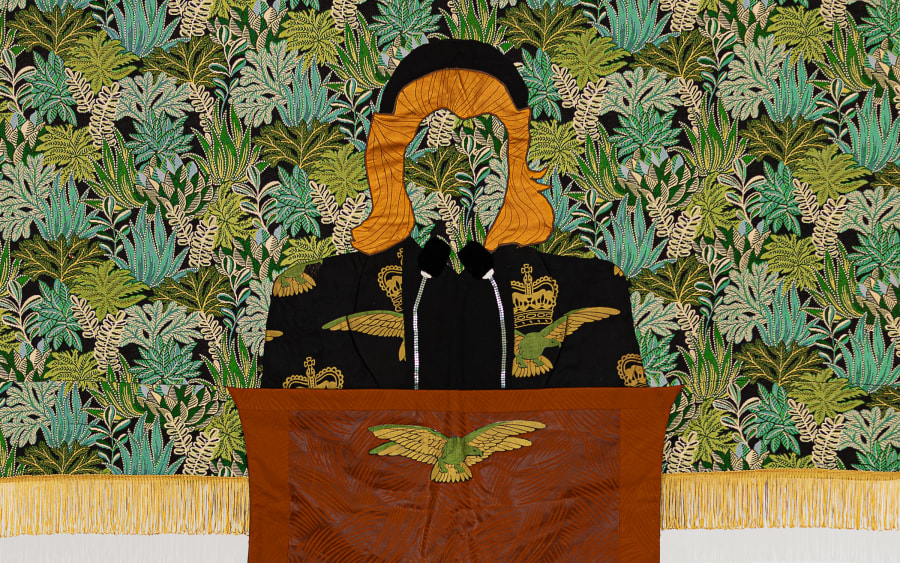駐紐約藝術家Jeremy Couillard原本是一名高中西班牙文教師,但在課堂之外,他投入大量時間創作複雜精細的漫畫和墨水畫。後來,他進入哥倫比亞大學攻讀藝術碩士,專心學習繪畫。但他很快感到厭倦:「我發現自己花在螢幕前的時間比在現實中的時間還多,因此科技話題越來越吸引我。甚至在畫畫時,我也大多是盯著電腦螢幕。」
因此,Couillard自學了程式設計,並開始嘗試動畫和3D遊戲創作工具虛幻引擎(Unreal Engine)。如今,他以創作敘事荒誕且帶有超現實主義風格的遊戲而聞名,比如《Escape from Lavender Island》(2023)。這款遊戲也在他目前於麻省理工學院李斯特視覺藝術中心(MIT List Visual Arts Center)舉辦的個展中佔據核心位置。觀眾可以坐在豆袋沙發上,化身遊戲主角Zede Aksis。這個綠色的雙足生物在監獄牢房中醒來,發現自己的反烏托邦城市夢境變成了現實。玩家的任務是逃離這個霓虹閃爍的恐怖都市。在逃亡中,他們追隨愛慕的物件,為舞蹈駐足,甚至可以戴上向路人噴射藥物的面具。Couillard談到這款帶有達達主義色彩的遊戲時說:「它關乎在城市中作為人類的生存體驗。遊戲很荒謬,但也的確非常悲涼。我想通過這款遊戲捕捉生存在當今社會的狀態。」
此次展覽還展示了一部隱隱透著詭秘氣息的視頻裝置,鏡頭掃過「Lavender Island」(薰衣草島)上奇異社區,伴隨著城市居民的旁白。不遠處,數碼繪製的木質花朵沿著地面綻放,牆上是幾幅色彩斑斕的畫作,猶如從遊戲中直接擷取的畫面。牆上還掛著一件滑稽的超大號螢光黃衛衣,上面印著「Depression」(抑鬱)。
展覽詼諧地批判了科技在社會中造成的疏離與隔閡。Couillard表示:「這種現象令人沮喪,但也讓人啼笑皆非,因為我們正在構建一個幾乎無人嚮往的科技世界,卻仍然義無反顧地向前推進。這個遊戲叫做《Escape from Lavender Island》(逃離薰衣草島),但在某種意義上,我們無法逃離現代生活。無論是福是禍,我們註定相伴。但我相信這終究是件好事,只要我們學會和彼此相處。」
Now 36, his tattoos and muscular frame give a hint to that youth of graffiti, skateboarding, and hip-hop concerts, and his love of street culture has continued in collaborations with various skate and fashion brands. Next month, he will debut his latest set of limited-edition products at Art Basel Miami Beach. ‘As it’s Miami, I thought I’d make stuff you might want to take to the beach,’ he says. There will be three tie-dye T-shirts, each featuring a different painting by Pjota printed against a swirling psychedelic background, a bag, a cap, and a notebook, plus some posters.
‘After my partner and I had a baby 3 months ago, I became very nostalgic,’ he says. ‘I started listening to music from when I was a teenager and watching cartoons again, so it seemed obvious that the T-shirts should be tie-dye. It’s a shame that has disappeared as a style.’
Fatherhood has ushered in a reflective mood more generally in his practice, too. His latest paintings reference drawings he used to make as a teen, and they are more surreal than previous work. Before visiting Pjota’s studio I saw the ‘Panorama’ exhibition at the Museu de Arte Contemporânea da Universidade de São Paulo, an annual survey of Brazilian art. The artist’s ‘Carta Marinha’ (Sea Chart, 2024) series dominates one section of the show: Five vibrantly orange, individually titled, canvases are hung tight alongside each other against a vast black-and-white wall drawing of a fantastical rainforest scene; on the canvases, fauns, salamanders, and sharks dance around blue flowers bunched in a chintzy pot.
The pot, he tells me, is based on a memory of one that was in his grandmother’s house, and for a recent exhibition at Mendes Wood DM in New York, Pjota mined further childhood recollections. The result was a series of works in which domestic scenes are rendered in a marvelously weird fashion. In Cenas de casa com flor estrelada (House scene with starry flowers, 2023), a vase with flowers sits on a side table while more flowers burst across a monochromatic peach background like supernovas. In Noite com Julia (Night with Julia, 2023), half a dozen further vases are pictured against the night sky, while a giant, supernatural genie-like female figure dominates the right side of the canvas. Similar paintings will feature in three forthcoming shows at Mendes Wood DM in Paris, François Ghebaly in Los Angeles, and a third at Kunstinstituut Melly in Rotterdam.
For these works, ‘I dug out all the drawings I made as a teenager in São José do Rio Preto,’ Pjota says rifling through a box on his studio desk. ‘I had them kept in drawers but hadn’t really looked at them. I wanted to look back at the old Paulo, the Paulo before I moved to São Paulo.’
The pencil and pen drawings of his youth were influenced by Greek mythology and pre-Columbian Brazilian art. They could easily be the basis of a tattoo or a skateboard design, but here, half-finished works, hanging on the studio walls as we speak, feature their motifs rendered in paint on canvas. ‘I’m mixing those drawings with domestic scenes, scenes I remember from my childhood home.’
While the type of motifs he uses in his work is changing, Pjota says he still owes a debt to the urban realm: ‘In my hometown, we would spend hours and hours walking the city looking for walls to use. We would walk everywhere, and I continued to do so even when I moved to São Paulo. This is how I started to think about images that don’t seem to belong together. In the city you have all these different pictures coming together and overlapping: posters, adverts, graffiti.’
This decontextualization and recontextualization of the image lies at the heart of Pjota’s work, old and new; it is what provides the latest work its unsettled, disconcerting quality, the canvas becoming a space in which plants and gods, flowers and monsters coexist. The image is also what provides both a flight of fancy (the kind that might preoccupy an imaginative young man in a quiet town) as well as a marker of time and place (the kind that triggers memories as we grow older).
Although Pjota has pursued many different avenues since his early exhibitions, he always comes back to the ideas that initially inspired him: ‘At art school I tried to be more conceptual, but I realized I already had a vocabulary, one that I learned when I was 12. I’m using that again now and making what I think is my best work.’
展覽「List Projects 30: Jeremy Couillard」由即日起至2024年10月6日於麻省理工學院李斯特視覺藝術中心展出。
本文作者Payal Uttam是一位常年於香港和新加坡兩地工作的獨立作家和編輯。她為不同出版物撰稿,包括Artsy、《藝術新聞》、《南華早報》及《華爾街日報》。
頁頂圖片標題:Jeremy Couillard,《Zede’s Dream》(靜幀),2023,圖片由藝術家提供
2024年9月2日發佈


